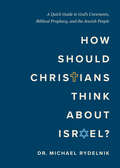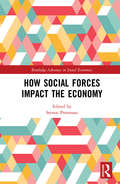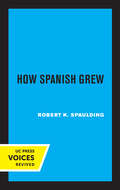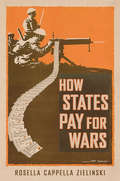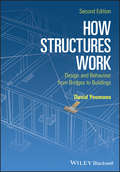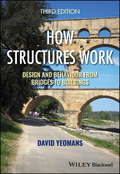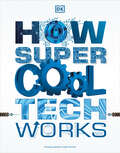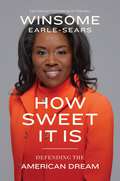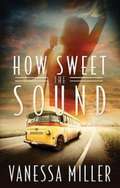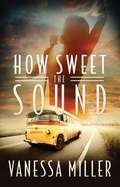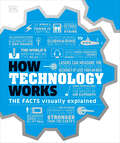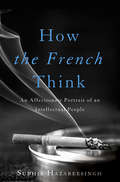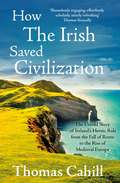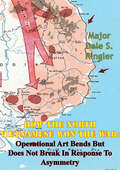- Table View
- List View
How Sherlock Pulled the Trick: Spiritualism and the Pseudoscientific Method
by Brian McCuskeyA masterful combination of literary study and author biography, How Sherlock Pulled the Trick guides us through the parallel careers of two inseparable men: Sherlock Holmes and his creator, Sir Arthur Conan Doyle. Reconsidering Holmes in light of Doyle’s well-known belief in Victorian spiritualism, Brian McCuskey argues that the so-called scientific detective follows the same circular logic, along the same trail of questionable evidence, that led Doyle to the séance room.Holmes’s first case, A Study in Scarlet, was published in 1887, when natural scientists and religious apologists were hotly debating their differences in the London press. In this environment, Doyle became convinced that spiritualism, as a universal faith based on material evidence, resolved the conflict between science and religion. The character of Holmes, with his infallible logic, was Doyle’s good faith solution to the cultural conflicts of his day. Yet this solution has evolved into a new problem. Sherlock Holmes now authorizes the pseudoscience that corrupts our public sphere, defying logic, revising history, and promoting conspiracy theories. As this book demonstrates, wearing a deerstalker does not make you a mastermind—more likely, it marks you as a crackpot.Fascinating and highly readable, How Sherlock Pulled the Trick returns the iconic Holmes to his mystical origins.
How Sherlock Pulled the Trick: Spiritualism and the Pseudoscientific Method
by Brian McCuskeyA masterful combination of literary study and author biography, How Sherlock Pulled the Trick guides us through the parallel careers of two inseparable men: Sherlock Holmes and his creator, Sir Arthur Conan Doyle. Reconsidering Holmes in light of Doyle’s well-known belief in Victorian spiritualism, Brian McCuskey argues that the so-called scientific detective follows the same circular logic, along the same trail of questionable evidence, that led Doyle to the séance room.Holmes’s first case, A Study in Scarlet, was published in 1887, when natural scientists and religious apologists were hotly debating their differences in the London press. In this environment, Doyle became convinced that spiritualism, as a universal faith based on material evidence, resolved the conflict between science and religion. The character of Holmes, with his infallible logic, was Doyle’s good faith solution to the cultural conflicts of his day. Yet this solution has evolved into a new problem. Sherlock Holmes now authorizes the pseudoscience that corrupts our public sphere, defying logic, revising history, and promoting conspiracy theories. As this book demonstrates, wearing a deerstalker does not make you a mastermind—more likely, it marks you as a crackpot.Fascinating and highly readable, How Sherlock Pulled the Trick returns the iconic Holmes to his mystical origins.
How Should Christians Think About Israel?: A Quick Guide to God's Covenants, Biblical Prophecy, and the Jewish People
by Michael RydelnikShould Christians support the modern state of Israel? How should we view Israel, the Jewish people, and the church? What makes Israel so special?Israel and the Jewish people always seem to be in the headlines. Terrorism. War. Antisemitism on university campuses and around the globe. Jews are the topics of conversation in podcasts, on school campuses, and in our homes. Yet Christians are wondering about the modern State of Israel and contemporary Jewish people. Are they related to the biblical kingdom of Israel and the ancient Jewish people of the Scriptures? Others question whether Jewish people are only God&’s people of yesterday, or do they have an ongoing place in God&’s plan? How does the Church relate to the Jewish people and why should Christians care about the Jewish people and their homeland? A biblical worldview ought to clarify our confusion and guide our viewpoints. How Should Christians Think about Israel? seeks to answer our questions, using a scriptural outlook rather than a political perspective. With the Bible as his guide, Dr. Michael Rydelnik takes readers to ancient prophecies and their fulfillment in modern times, exploring Israel&’s unique identity and the special role Israel will play in God&’s plan.This essential resource provides clear and sensible answers to your questions about Israel and the Jewish people. Having served as Professor of Jewish Studies and Bible at Moody Bible Institute for more than 30 years, Dr. Rydelnik is uniquely able to bring scriptural insight and practical positions to the controversial and confusing subject of Israel and the Jewish people.
How Social Forces Impact the Economy (Routledge Advances in Social Economics)
by Steven PressmanSocial forces are important determinants of how people behave, how economies work at the macroeconomic level, and the effectiveness of economic policies. However, this dimension is generally overlooked in mainstream economics. How Social Forces Impact the Economy demonstrates that a broader conception of social economics provides for a better understanding of how economies work as a whole. This book argues that adopting a truly social approach to economics opens the door to studying how people form preferences, and how they learn by taking cues from others about how to behave and what to consume. Each chapter contributor works to highlight the breadth of new insights and possibilities that emerge from a fuller understanding of social economics. Part I focuses on microeconomics, bringing individual behaviors and individual entrepreneurs into a more social context. Part II focuses on macroeconomic topics, such as how money and quasi-monies (like Bitcoins) are social, how money developed as a social institution, and how social forces matter for economic development. Finally, Part III looks at the consequences of considering social factors when it comes to policy: environmental policy, industrial policy, and policies promoting greater equality. This book is invaluable reading to anyone interested in the relationship between economics and sociology, how social forces affect policy effectiveness, human behavior, and the overall economy.
How Social Movements Die
by Christian DavenportHow do social movements die? Some explanations highlight internal factors like factionalization, whereas others stress external factors like repression. Christian Davenport offers an alternative explanation where both factors interact. Drawing on organizational, as well as individual-level, explanations, Davenport argues that social movement death is the outgrowth of a coevolutionary dynamic whereby challengers, influenced by their understanding of what states will do to oppose them, attempt to recruit, motivate, calm, and prepare constituents while governments attempt to hinder all of these processes at the same time. Davenport employs a previously unavailable database that contains information on a black nationalist/secessionist organization, the Republic of New Africa, and the activities of authorities in the U. S. city of Detroit and state and federal authorities.
How Societies Are Born: Governance in West Central Africa before 1600
by Jan VansinaLike stars, societies are born, and this story deals with such a birth. It asks a fundamental and compelling question: How did societies first coalesce from the small foraging communities that had roamed in West Central Africa for many thousands of years?Jan Vansina continues a career-long effort to reconstruct the history of African societies before European contact in How Societies Are Born. In this complement to his previous study Paths in the Rainforests, Vansina employs a provocative combination of archaeology and historical linguistics to turn his scholarly focus to governance, studying the creation of relatively large societies extending beyond the foraging groups that characterized west central Africa from the beginning of human habitation to around 500 BCE, and the institutions that bridged their constituent local communities and made large-scale cooperation possible.The increasing reliance on cereal crops, iron tools, large herds of cattle, and overarching institutions such as corporate matrilineages and dispersed matriclans lead up to the developments treated in the second part of the book. From about 900 BCE until European contact, different societies chose different developmental paths. Interestingly, these proceeded well beyond environmental constraints and were characterized by "major differences in the subjects which enthralled people," whether these were cattle, initiations and social position, or "the splendors of sacralized leaders and the possibilities of participating in them."
How Societies Remember
by Paul ConnertonIn treating memory as a cultural rather than an individual faculty, this book provides an account of how bodily practices are transmitted in, and as, traditions. Most studies of memory as a cultural faculty focus on written, or inscribed transmissions of memories. Paul Connerton, on the other hand, concentrates on bodily (or incorporated) practices, and so questions the currently dominant idea that literary texts may be taken as a metaphor for social practices generally. The author argues that images of the past and recollected knowledge of the past are conveyed and sustained by ritual performances and that performative memory is bodily. Bodily social memory is an essential aspect of social memory, but it is an aspect which has until now been badly neglected. An innovative study, this work should be of interest to researchers into social, political and anthropological thought as well as to graduate and undergraduate students.
How Socrates Became Socrates: A Study of Plato’s Phaedo, Parmenides, and Symposium
by Laurence LampertPlato dispersed his account of how Socrates became Socrates across three dialogues. Thus, Plato rendered his becoming discoverable only to readers truly invested. In How Socrates Became Socrates, Laurence Lampert recognizes the path of Plato’s strides and guides us through the true account of Socrates’ becoming. He divulges how and why Plato ordered his Phaedo, Parmenides, and Symposium chronologically to give readers access to Socrates’ development on philosophy’s fundamental questions of being and knowing. In addition to a careful and precise analysis of Plato’s Phaedo,Parmenides, and Symposium, Lampert shows that properly entwined, Plato’s three dialogues fuse to portray a young thinker entering philosophy’s true radical power. Lampert reveals why this radicality needed to be guarded and places this discussion within the greater scheme of the politics of philosophy.
How Spanish Grew
by Robert K. SpauldingThis book traces the evolution of the Spanish language from pre-Roman days to the present and stresses the influence of social and political events on its development. After a short discussion of the Indo-European tongues, Spaulding reviews the effects on Spanish of the languages of the pre-Roiman invaders, the Visigoths and other Germanic tribes, and the Arabs. The later development of Spanish is divided into four periods: Old Spanish (to 1500), Spanish Ascendancy (1500 - 1700), French Prestige (1700 - 1808), and Modern Spanish (1808 - ). Within this framework, the author discusses the evolution of sounds, forms, constructions, style, vocabulary, and orthography. The final chapter deals also with modern slang, popular Spanish, and the various Spanish dialects, including Leonese, Aragonese, and Andalusian. The book has interest and value for anyone interested in language, teachers (both high school and college), and students. Its organization makes it usable in any course dealing with the Spanish language historically, or even by student of Spanish literature of history who wan tot consider the state of the language at a given period. This title is part of UC Press's Voices Revived program, which commemorates University of California Press's mission to seek out and cultivate the brightest minds and give them voice, reach, and impact. Drawing on a backlist dating to 1893, Voices Revived makes high-quality, peer-reviewed scholarship accessible once again using print-on-demand technology. This title was originally published in 1943.
How States Pay for Wars
by Rosella Capella ZielinskiArmies fight battles, states fight wars. To focus solely on armies is to neglect the broader story of victory and defeat. Military power stems from an economic base, and without wealth, soldiers cannot be paid, weapons cannot be procured, and food cannot be bought. War finance is among the most consequential decisions any state makes: how a state finances a war affects not only its success on the battlefield but also its economic stability and its leadership tenure. In How States Pay for Wars, Rosella Cappella Zielinski clarifies several critical dynamics lying at the nexus of financial and military policy.Cappella Zielinski has built a custom database on war funding over the past two centuries, and she combines those data with qualitative analyses of Truman's financing of the Korean War, Johnson’s financing of the Vietnam War, British financing of World War II and the Crimean War, and Russian and Japanese financing of the Russo-Japanese War. She argues that leaders who attempt to maximize their power at home, and state power abroad, are in a constant balancing act as they try to win wars while remaining in office. As a result of political risks, they prefer war finance policies that meet the needs of the war effort within the constraints of the capacity of the state.
How States Shaped Postwar America: State Government and Urban Power
by Nicholas Dagen BloomThe history of public policy in postwar America tends to fixate on developments at the national level, overlooking the crucial work done by individual states in the 1960s and ’70s. In this book, Nicholas Dagen Bloom demonstrates the significant and enduring impact of activist states in five areas: urban planning and redevelopment, mass transit and highways, higher education, subsidized housing, and the environment. Bloom centers his story on the example set by New York governor Nelson Rockefeller, whose aggressive initiatives on the pressing issues in that period inspired others and led to the establishment of long-lived state polices in an age of decreasing federal power. Metropolitan areas, for both better and worse, changed and operated differently because of sustained state action—How States Shaped Postwar America uncovers the scope of this largely untold story.
How States Think: The Rationality of Foreign Policy
by John J. Mearsheimer Sebastian RosatoA groundbreaking examination of a central question in international relations: Do states act rationally? To understand world politics, you need to understand how states think. Are states rational? Much of international relations theory assumes that they are. But many scholars believe that political leaders rarely act rationally. The issue is crucial for both the study and practice of international politics, for only if states are rational can scholars and policymakers understand and predict their behavior. John J. Mearsheimer and Sebastian Rosato argue that rational decisions in international politics rest on credible theories about how the world works and emerge from deliberative decision‑making processes. Using these criteria, they conclude that most states are rational most of the time, even if they are not always successful. Mearsheimer and Rosato make the case for their position, examining whether past and present world leaders, including George W. Bush and Vladimir Putin, have acted rationally in the context of momentous historical events, including both world wars, the Cold War, and the post–Cold War era. By examining this fundamental concept in a novel and comprehensive manner, Mearsheimer and Rosato show how leaders think, and how to make policy for dealing with other states.
How Structures Work
by David YeomansStructural engineering is central to the design of a building. How the building behaves when subjected to various forces - the weight of the materials used to build it, the weight of the occupants or the traffic it carries, the force of the wind etc - is fundamental to its stability. The alliance between architecture and structural engineering is therefore critical to the successful design and completion of the buildings and infrastructure that surrounds us. Yet structure is often cloaked in mathematics which many architects and surveyors find difficult to understand. How Structures Work has been written to explain the behaviour of structures in a clear way without resorting to complex mathematics. This new edition includes a new chapter on construction materials, and significant revisions to, and reordering of the existing chapters. It is aimed at all who require a good qualitative understanding of structures and their behaviour, and as such will be of benefit to students of architecture, architectural history, building surveying and civil engineering. The straightforward, non-mathematical approach ensures it will also be suitable for a wider audience including building administrators, archaeologists and the interested layman.
How Structures Work: Design and Behaviour from Bridges to Buildings
by David YeomansHOW STRUCTURES WORK DESIGN AND BEHAVIOUR FROM BRIDGES TO BUILDINGS, THIRD EDITION DAVID YEOMANS Structural engineering is essential to the design of a building. How the building behaves when subjected to various forces – the weight of the materials used to build it, the weight of the occupants or the traffic it carries, the force of the wind, etc. – is fundamental to its stability. The alliance between architecture and structural engineering is therefore critical to the successful design and completion of the buildings and infrastructure that surrounds us. Yet structure is often cloaked in mathematics which many architects and surveyors find difficult to understand. How Structures Work has been written to explain the bahaviour of structures in a clear way without resorting to complex mathematics. It is aimed at all who require a good qualitative understanding of structures, their behaviour, and design, and as such will be of benefit to students of architecture, architectural history, building surveying and civil engineering. The straightforward, nonmathematical approach ensures it will also be suitable for a wider audience including building administrators and the interested layman. This new edition includes a new chapter to deal with some little understood structures both ancient and modern. Reviews of the first edition “How Structures work is the most compelling on structures that I have ever read. And I have read a lot of books on structures.” —R.L.Brungraber, Ph.D., P.E Timber Framing: Journal of the Timber Framers Guild, December 2009 “The author writes beautifully. It is a user-friendly engaging book to read and one that is very easy to understand. One learns a lot by reading it … I think it should be a compulsory text for all first year engineering students.” From a review of the first edition commissioned by the publisher.
How Super Cool Tech Works
by DKDiscover the mind-blowing high-tech inventions of the future! Incredible images reveal the secret inner workings of everything from drones and supercomputers to underwater hotels and flying cars.How Super Cool Tech Works explains how incredible technologies will shape the world of tomorrow. Explore robotics, space rockets, artificial intelligence, and even game consoles in this cutting-edge non-fiction science book for kids aged 9 and over. Also featured are state-of-the-art buildings, new ways of traveling, imaginative entertainment gadgets, and even how teleportation and invisibility cloaks might be possible in the future. Each exciting subject is explained in detail, via crisp images and engaging, child-friendly text. "How it works" panels explain each subject&’s secret inner workings.New and updated for 2020, How Super Cool Tech Works is a one-stop shop for kids who want to know what the latest and greatest technologies are, and how they will shape our world in the years to come.
How Sweet It Is: Defending the American Dream
by Winsome Earle-SearsThe first Black woman elected to statewide office in Virginia reveals in her memoir how her Christian faith, unwavering patriotism, and fervent commitment to conservative principles propelled her to serve and sacrifice for her country and a better future. Winsome Earle-Sears sent shock waves across Virginia and the country at large when she pulled off her stunning upset victory in November 2021 and became the first woman lieutenant governor of Virginia and the first Black woman, the first naturalized female citizen, and first female veteran elected to statewide office. She earned intense national coverage because of her unwavering support for Second Amendment rights and her strong commitment to education opportunity for all students. Now in her memoir, How Sweet It Is, Winsome will tell her story and explain how she arrived at that historic moment in time. A devout Christian, Winsome is also a true believer in the promise of the American Dream. Her father was approved to immigrate to the U.S.A. and left Jamaica, arriving in America on August 11, 1963, with only $1.75 in his pocket. Winsome joined him when she was just six years old, and ever since she has never ceased enthusiastically bucking conventions, defying expectations, and charging straight toward challenges. Winsome&’s remarkable story is one of faith and family, personal loss and perseverance, philanthropy and patriotism, service and sacrifice. But through it all, her Christian faith sustained her, drove her, and compelled her to give back to her community and her country. Her unyielding belief in the fundamental righteousness of America stands in stark opposition to the increasingly pervasive ideologies that are dividing the country. In How Sweet It Is, Winsome encourages Americans to never stop fighting for their country and shows them how to chart a new path forward.
How Sweet the Sound
by Vanessa MillerShar Gracey wants nothing more than to sing the Lord's praises, so she jumps at the chance to join a traveling choir led by the father of black gospel music, Thomas A. Dorsey. Better yet, the opportunity will give her money to pay for her ailing mother's medical care. While on tour she falls under the tutelage of gospel great Mahalia Jackson--and falls for the handsome but not-so-great Nicoli James, whose desires for Shar are fueled by his own greed. Shar would do anything for Nicoli--and he knows it--so when his life is threatened after a night of gambling, Shar agrees to help pay Nicoli's debt, only to have her faith and dreams shattered. Reeling from the betrayal, Shar loses her voice and she believes that she will never sing again. She has no place to run except back home to her seriously ill mother--and the man she left behind, who would move heaven and earth to make Shar's pain go away. Even if it means he has to let her go . . . again.
How Sweet the Sound
by Vanessa MillerShar Gracey wants nothing more than to sing the Lord's praises, so she jumps at the chance to join a traveling choir led by the father of black gospel music, Thomas A. Dorsey. Better yet, the opportunity will give her money to pay for her ailing mother's medical care. While on tour she falls under the tutelage of gospel great Mahalia Jackson--and falls for the handsome but not-so-great Nicoli James, whose desires for Shar are fueled by his own greed. Shar would do anything for Nicoli--and he knows it--so when his life is threatened after a night of gambling, Shar agrees to help pay Nicoli's debt, only to have her faith and dreams shattered. Reeling from the betrayal, Shar loses her voice and she believes that she will never sing again. She has no place to run except back home to her seriously ill mother--and the man she left behind, who would move heaven and earth to make Shar's pain go away. Even if it means he has to let her go . . . again.
How Technology Works: The Facts Visually Explained (DK How Stuff Works)
by DKHave you ever asked yourself how the inventions, gadgets, and devices that surround us actually work? Discover the hidden workings of everyday technology with this graphic guide.How Technology Works demystifies the machinery that keeps the modern world going, from simple objects such as zip fasteners and can openers to the latest, most sophisticated devices of the information age, including smartwatches, personal digital assistants, and driverless cars. It includes inventions that have changed the course of history, like the internal combustion engine, as well as technologies that might hold the key to our future survival, including solar cells and new kinds of farming to feed a growing population. Throughout the book, step-by-step explanations are supported by simple and original graphics that take devices apart and show you how they work. The opening chapter explains principles that underpin lots of devices, from basic mechanics to electricity to digital technology. From there, devices are grouped by application--such as the home, transportation, and computing--making them easy to find and placing similar devices side by side. How Technology Works is perfect for anyone who didn't have training in STEM subjects at school or is simply curious about how the modern world works.
How The French Think: An Affectionate Portrait Of An Intellectual People
by Sudhir HazareesinghIn France, perhaps more so than anywhere else, intellectual activity is a way of life embraced by the majority of society, not just a small group of élite thinkers. And because French thought has also shaped the Western world, Sudhir Hazareesingh argues in How the French Think, we cannot hope to understand modern history without first making sense of the French mind-set. Hazareesingh traces the evolution of French thought from Descartes and Rousseau to Sartre and Derrida. In the French intellectual tradition, he shows, recurring themes have pervaded nearly every aspect of French life, from the rhetorical flair once embodied by the philosophes to the country’s modern embrace of secularism. Sweeping aside generalizations and easy stereotypes, Hazareesingh offers an erudite portrait of the venerated tradition of French thought and the people who embody it.
How The Indians Lost Their Land: Law And Power On The Frontier
by Stuart BannerBetween the early seventeenth century and the early twentieth,nearly all the land in the United States was transferred from AmericanIndians to whites. This dramatic transformation has been understood in two very different ways--as a series of consensual transactions, but also as a process of violent conquest. Both views cannot be correct. How did Indians actually lose their land? <p><p> Stuart Banner provides the first comprehensive answer. He argues that neither simple coercion nor simple consent reflects the complicated legal history of land transfers. Instead, time, place, and the balance of power between Indians and settlers decided the outcome of land struggles. As whites' power grew, they were able to establish the legal institutions and the rules by which land transactions would be made and enforced. <p> This story of America's colonization remains a story of power, but a more complex kind of power than historians have acknowledged. It is a story in which military force was less important than the power to shape the legal framework within which land would be owned. As a result, white Americans--from eastern cities to the western frontiers--could believe they were buying land from the Indians the same way they bought land from one another. How the Indians Lost Their Land dramatically reveals how subtle changes in the law can determine the fate of a nation, and our understanding of the past.
How The Irish Saved Civilization: The Untold Story of Ireland's Heroic Role from the Fall of Rome to the Rise of Medieval Europe
by Thomas Cahill'Shamelessly engaging, effortlessly scholarly, utterly refreshing history of the Irish soul and its huge contribution to Western culture' Thomas KeneallyIreland played the central role in maintaining European culture when the dark ages settled on Europe in the fifth century: as Rome was sacked by Visigoths and its empire collapsed, Ireland became 'the isle of saints and scholars' that enabled the classical and religious heritage to be saved.In his compelling and entertaining narrative, Thomas Cahill tells the story of how Irish monks and scrines copied the mauscripts of both pagan and Christian writers, including Homer and Aristotle, while libraries on the continent were lost forever. Bringing the past and its characters to life, Cahill captures the sensibility of the unsung Irish who relaunched civilisation.
How The North Vietnamese Won The War: Operational Art Bends But Does Not Break In Response To Asymmetry
by Major Dale S. RinglerThis monograph analyzes the effectiveness of operational campaign design against an asymmetrical threat during the 1968 Tet Offensive. The focus is on conceptual elements of campaign design that are derived from theory, which incorporate the particulars of military history to the general truth of warfare. Effective campaign execution is dependent, in part, on effective campaign design that set of theoretical and doctrinal precepts that define the concerns of the operational planner. The monograph identifies lessons learned from this period that are applicable to current U.S. Joint and Army doctrine as well as lessons for planners and executors of U.S. military action under the American system of civilian control of the military.First, the monograph demonstrated the complex nature of asymmetric warfare. Finding and creating vulnerabilities and attacking those vulnerabilities with inherent strengths is the key to asymmetric warfare. Secondly, the monograph discussed the elements of campaign design that are derived from theory, which incorporate the particulars of military history to the general truth of warfare. Some of the more common conceptual actions are to understand the type and scope of conflict, define the enemy and friendly center of gravity, identify possible culminating points, select lines of operation, determine decisive points, and understanding the dangers of paralysis commonly known as cyber shock. The third section identifies the strategy and identifies particular military objectives identified by the North Vietnamese.
How The West Was Lost: The Transformation Of Kentucky From Daniel Boone To Henry Clay
by Stephen AronEighteenth-century Kentucky was a place where Indian and European cultures collided-and, surprisingly, coincided. But this mixed world did not last, and it eventually gave way to nineteenth-century commercial and industrial development. How the West Was Lost tracks the overlapping conquest, colonization, and consolidation of the trans-Appalachian frontier. Not a story of paradise lost, this is a book about possibilities lost. It focuses on the common ground between Indians and backcountry settlers which was not found, the frontier customs that were not perpetuated, the lands that were not distributed equally, the slaves who were not emancipated, the agrarian democracy that was not achieved, and the millennium that did not arrive. Seeking to explain why these dreams were not realized, Stephen Aron shows us what did happen during Kentucky's tumultuous passage from Daniel Boone's world to Henry Clay's.
How The World Was Won: The Americanization of Everywhere
by Peter ConradFrom politics and war, to jeans and sneakers: a look at America's influence on the world from an international perspective On the day after 9/11, foreign newspapers ran headlines announcing "We Are All Americans Now." Though the sentiment was not new, it was also not quite the same as when Henry Luce announced in 1941, the inauguration of what he called "the American Century," during which the US was to raise all men "from the level of the beasts to what the Psalmist calls a little lower than angels." When America suddenly emerged as a global power in the postwar period, the world--with pockets of resistance from France, Russia, and Japan in particular--was happy to be remade in the US image. America dazzled, and sometimes intimidated, older, staler, less innovative cultures. The affluence it placed on display was something to which most other countries aspired, and it was this fantasy that helped win the Cold War. Fast forward to today and the Chinese state news agency Xinhua, days before a possible financial default by the US government, calling for a de-Americanized world. A context for Peter Conrad's grand tale is, inevitably, politics, war, and commerce, but for the most part he draws on his brilliant repertoire of cultural skills to assess, surprise, invigorate, and delight us with his kaleidoscopic presentation of the movies and music, jeans and sneakers, food and refrigerators, novels and paintings that have shaped so much of the world in our lifetimes.

